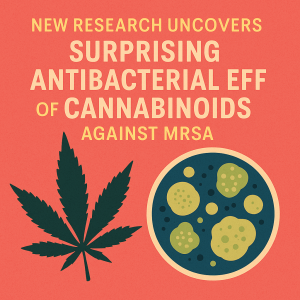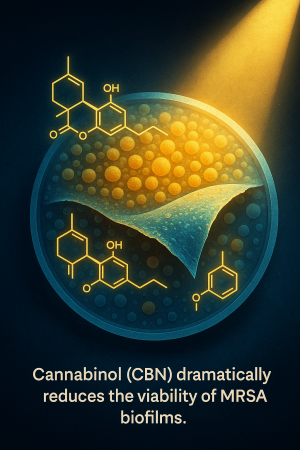Table of Contents
- What cannabis compounds reveal about fighting superbugs and sticky biofilms
- The Unexpected Bouncers at the Microbial Party
- What You’ll Learn in This Post
- Study Reference: Who, What, and Where
- Why MRSA Matters More Than We Admit
- What the Lab Reveals About Cannabinoids Against MRSA
- How These Cannabinoids Do Their Dirty Work
- From Lab Bench to Bedside: The Translation Challenge
- What the Bigger Picture Shows: Two Decades of Clues
- Clinical and Public Health Implications: Where Might This Actually Matter?
- Clinical and Public Health Implications: Where Might This Actually Matter?
- How Cannabinoids Compare to Other Natural Antimicrobials
- The Memorable Punchline: Why This Story Sticks
- Internal Links from CEDclinic.com
- External Links:
- Curious Facts About MRSA
- Global MRSA & AMR burden (what scale are we talking about?)
- Colonization & who carries it
- U.S. illness & deaths (how big is the problem here?)
- Europe (incidence & resistance snapshot)
- Costs of care (what does MRSA do to budgets?)
- How MRSA stacks up against other bacterial threats
- Quick clarifications (common pitfalls I double-checked)
- 10 FAQ Questions on the topic!
- Q1: Can cannabinoids kill MRSA?
- Q2: Which cannabinoid is most effective against MRSA?
- Q3: How do cannabinoids fight MRSA?
- Q4: Are cannabinoids as strong as antibiotics like vancomycin?
- Q5: Can cannabinoids be used as antibiotics in hospitals?
- Q6: Do cannabinoids work against biofilms?
- Q7: Could cannabis oil cure an infection?
- Q8: Are cannabinoids effective against all bacteria?
- Q9: What natural products compare to cannabinoids against MRSA?
- Q10: What’s the future of cannabinoids in infectious disease care?
What cannabis compounds reveal about fighting superbugs and sticky biofilms
The Unexpected Bouncers at the Microbial Party
Antibiotic resistance is one of those global problems that doesn’t make the nightly news nearly as often as it should. Yet behind the scenes, bacteria like MRSA (methicillin-resistant Staphylococcus aureus) are doing their best impression of an uninvited houseguest—spreading, sticking, and refusing to leave. MRSA hides in sticky biofilms, resists the standard cleaning crew of antibiotics, and has cost hundreds of thousands of lives worldwide.
Now imagine, in this microscopic standoff, a group of unlikely enforcers shows up: cannabinoids. Yes, the very compounds more famous for easing pain, calming anxiety, or sparking debate at dinner tables may also have a knack for dealing with MRSA. Recent laboratory studies on cannabinoids against MRSA reveal that some cannabis molecules don’t just hang around—they bust biofilms, punch holes in bacterial membranes, and set off oxidative fireworks.
This isn’t to say we’re about to start prescribing cannabis oil for infected knee replacements. But it does raise eyebrows, and maybe hope, that cannabinoids could one day expand their résumé into the world of infectious disease.
What You’ll Learn in This Post
🦠 Why MRSA is such a notorious, sticky foe in hospitals and beyond
🌿 How cannabinoids against MRSA show potent lab activity, sometimes rivaling standard antibiotics
⏱ Which cannabinoid compounds act like sprinters (rapid kill) and which work like burglars sneaking into biofilms
⚡ The biological tricks—ROS bursts and membrane disruption—that explain how these molecules do their dirty work
🚧 Why the leap from petri dish to patient care is a long road, with obstacles like serum binding and delivery challenges
Study Reference: Who, What, and Where
For readers who like to see the fine print, the work we’ve been discussing comes from the paper “The Anti-Biofilm Activity of Cannabinoids Against Methicillin-Resistant Staphylococcus aureus” authored by Islam M. Khalifa, Katherine E. Jones, Surendra Raj Sharma, Bhaskar Chellappan, and Joshua P. King. By naming the study directly, it helps underscore that these insights aren’t speculation—they come from peer-reviewed research exploring cannabinoids against MRSA in rigorous laboratory assays.
Why MRSA Matters More Than We Admit
If bacteria had yearbooks, MRSA would be voted “Most Likely to Overstay Its Welcome.” It’s not just another germ—it’s the bacterial equivalent of a master lock-picker. Resistant to methicillin and related antibiotics, MRSA has become a poster child for antimicrobial resistance, a problem the Lancet estimated kills more than 1.27 million people globally every year. That’s not counting the millions more whose lives are cut short because drug-resistant infections complicated their care.
Here’s where MRSA stands out from the microbial crowd: its knack for forming biofilms. Picture an invisible Jell-O mold that bacteria build to live inside. These slimy fortresses cling to catheters, joint replacements, heart valves, and even wounds. Once MRSA sets up shop inside a biofilm, antibiotics and immune cells struggle to get through. It’s part shield, part sticky glue, and part chemical fortress.
For patients, this means infections that drag on for weeks, months, or even years. For hospitals, it means longer stays, higher costs, and endless headaches. And for researchers, it means the hunt for novel tools—new compounds, new approaches, new bouncers who can shove MRSA out the door—isn’t optional, it’s urgent.
This is why the recent lab work exploring cannabinoids against MRSA is more than just a curiosity. It hints at a possible new playbook: one where plant-derived molecules don’t simply reduce pain or calm nerves, but also cut through biofilms and put pressure on some of the toughest bugs in modern medicine.
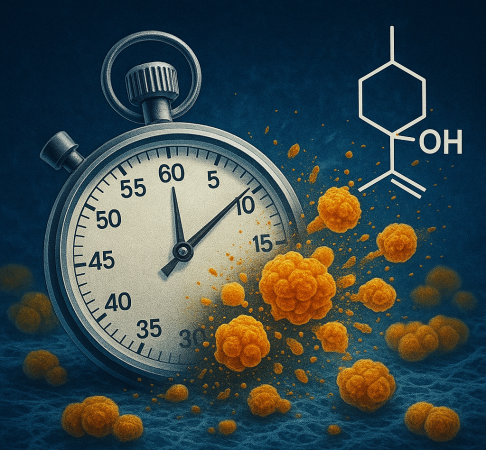
What the Lab Reveals About Cannabinoids Against MRSA
When researchers put MRSA and cannabinoids in the same petri dish, the results were eye-catching. All five of the major cannabis compounds tested—CBD, THC, CBN, CBG, and CBC—showed the ability to stop MRSA in its tracks at impressively low concentrations. For context, CBD held its ground with a minimum inhibitory concentration (MIC) of about 2 µg/mL, which in this model matched the MIC of vancomycin, one of the last-resort antibiotics hospitals cling to. The others—THC, CBN, CBG, and CBC—were even more potent, clocking in at MICs around 1 µg/mL. That’s not nothing.
But the real fun began when the researchers looked at how each cannabinoid behaved beyond the basic growth test. CBC proved itself the sprinter of the group, causing a near-total collapse of MRSA populations in just 30 minutes at double its MIC. CBG wasn’t far behind, clearing the bacteria within an hour. CBN, THC, and CBD eventually finished the race too, but they needed about four hours to reach the same point. Think of CBC as the Usain Bolt of bacterial takedown, while the others jogged in for a later victory lap.
Then there was the matter of MRSA’s sticky calling card: biofilms. In this department, CBN and CBG shined brightest. CBN, in particular, reduced the viability of biofilm-embedded bacteria by roughly 85% at just 1 µg/mL. That’s a big deal, because biofilms are notoriously stubborn—like coffee stains on white shirts, they cling to surfaces and resist every attempt to wash them out.
Different cannabinoids also showed different “styles” of attack. CBD was especially good at punching holes in bacterial membranes, while CBN and CBG ramped up reactive oxygen species (ROS)—a chemical storm inside bacterial cells that’s a little like setting off fireworks in a crowded room. Together, these varied tactics give cannabinoids against MRSA a kind of tag-team versatility: some slash through defenses, others stir up chaos from the inside.
Of course, all this happens in a controlled lab setting, without the messiness of blood, tissue, or an immune system. But as a proof-of-concept, the results are intriguing: cannabis molecules can act as both sprinters and burglars, racing toward free-floating bacteria while also sneaking into biofilms that most antibiotics can barely scratch.
How These Cannabinoids Do Their Dirty Work
So how do cannabinoids against MRSA actually land their punches? It comes down to two main tricks: messing with membranes and unleashing chemical chaos.
First, membranes. Bacterial cells are wrapped in delicate lipid envelopes, a bit like soap bubbles. If you poke enough holes in those bubbles, the whole thing collapses. That’s what CBD excelled at in this study—acting like a pin in a crowded balloon shop. The result? Bacteria leak, deflate, and die.
Then there’s the fireworks show: reactive oxygen species (ROS). Think of ROS as tiny chemical grenades that, when unleashed inside a bacterial cell, shred DNA, proteins, and everything in between. CBN and CBG were especially good at turning up the ROS dial, cranking the cellular chaos to 11. In lab tests, CBN generated nearly an eight-fold surge in ROS, while CBG wasn’t far behind. That’s not just noise—it’s oxidative pandemonium that MRSA struggles to survive.
Different cannabinoids emphasize different strategies, which is part of what makes this story interesting. CBC races to kill in a sprint. CBN and CBG sneak into biofilms and trigger chemical storms. CBD slips in and punctures bacterial bubbles. THC, though less flashy in this set of experiments, still played a steady supporting role. In other words: the cannabis toolbox isn’t one hammer—it’s a whole row of oddly shaped keys, each able to jiggle open a different microbial lock.
Of course, it’s worth repeating: this is all petri-dish science. Once you add blood, tissue, and an immune system, things change. Still, the idea that cannabinoids against MRSA can topple bacteria through both brute-force membrane attack and subtle oxidative sabotage adds a fascinating twist to the growing literature on cannabis and human health.
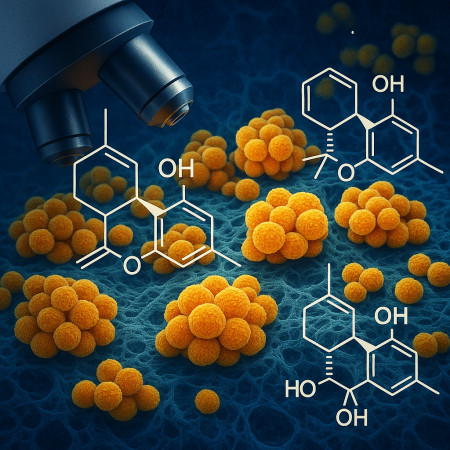
From Lab Bench to Bedside: The Translation Challenge
If you’ve made it this far, you might be wondering: why aren’t hospitals already stocking cannabis compounds in their infection-fighting kits? The answer is that between the petri dish and the patient lies a canyon filled with messy variables.
The biggest obstacle is blood. In lab media, cannabinoids against MRSA look strong. But once you add serum—the protein-rich soup inside the body—some cannabinoids lose much of their punch. CBD, for example, can bind tightly to serum proteins, leaving less “free” drug to actually act on bacteria. It’s like hiring a bodyguard only to have them stuck holding coats at the party instead of keeping order.
Then there’s the matter of strain diversity. The MRSA tested here was a reference strain, a kind of lab stand-in. Out in the wild, MRSA strains vary like dog breeds—some small and scrappy, others massive and stubborn. What works beautifully against one strain may fizzle against another. Without testing cannabinoids across a panel of clinical isolates, we don’t know how broadly the results apply.
Delivery is another challenge. Topical use—say, in wound dressings or coated medical devices—seems the most realistic short-term avenue, because you can flood the local area with high concentrations. But systemic therapy, where a pill or IV delivers cannabinoids throughout the body, is another matter entirely. The hurdles are steep: solubility, metabolism, dosing, and toxicity all need careful study.
So yes, cannabinoids against MRSA are compelling in vitro. But turning that promise into a prescription requires more than enthusiasm. It requires the slow grind of preclinical work: testing in serum and tissue models, mapping pharmacokinetics, evaluating toxicity, and running animal infection studies. The science is real—but so are the roadblocks.
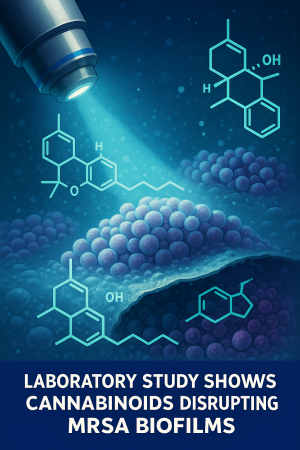
What the Bigger Picture Shows: Two Decades of Clues
One paper alone doesn’t change medicine. But when you step back, a pattern begins to emerge. The idea of cannabinoids against MRSA isn’t new—it’s been quietly building for almost twenty years.
Back in 2008, a team led by Giovanni Appendino published a now-classic paper in Journal of Natural Products. They showed that the five major cannabinoids—CBD, THC, CBN, CBG, and CBC—could all stop MRSA strains in their tracks, often at concentrations comparable to standard antibiotics. That was the “spark” paper, the one that planted a seed in microbiology circles.
Fast forward to 2020, when Farha and colleagues dug deeper into CBG. Their work in ACS Infectious Diseases revealed that CBG doesn’t just work in test tubes; it can also eradicate biofilms and kill “persister” cells—those stubborn bacterial holdouts that refuse to die, even when most of their friends have been wiped out. Even more striking, they demonstrated that CBG could treat MRSA infections in a mouse model. Suddenly, cannabinoids weren’t just test-tube curiosities—they were showing animal-level efficacy.
Then in 2021, Blaskovich and colleagues confirmed CBD’s activity against Gram-positive bacteria, including MRSA. They also highlighted a critical limitation: CBD’s potency plummets in the presence of serum. It was a reminder that the leap from lab to clinic isn’t straightforward. Still, they went further, showing that CBD worked topically in infected skin models, proving at least one plausible path toward medical application.
Now comes the most recent wave of research, including the study we’ve been unpacking here, which adds nuance: different cannabinoids don’t act the same way. CBC is the sprinter, CBN the biofilm burglar, CBG the membrane wrecking ball, CBD the bubble-popper, and THC the steady background player. Together, these findings sketch a bigger, messier, and more intriguing picture.
The throughline is clear: across multiple labs, multiple years, and multiple methods, cannabinoids against MRSA consistently show up as potent, versatile, and mechanistically interesting antibacterial agents. Whether that will translate into new therapies is still uncertain—but the drumbeat of evidence is hard to ignore.
Clinical and Public Health Implications: Where Might This Actually Matter?
The million-dollar question isn’t whether cannabinoids against MRSA can topple bacteria in a petri dish—we already know they can. The real question is: where could that actually matter in the messy, protein-rich, biofilm-prone environments of human health?
The most obvious entry point is topical use. Imagine wound dressings infused with cannabinoids, or gels designed to keep bacterial growth at bay on diabetic ulcers, burns, or surgical incisions. In these scenarios, the concentrations needed to overwhelm bacteria are easier to achieve, and the risk of systemic side effects is lower. CBD already has topical safety data in humans, making it a candidate worth exploring.
Another avenue is device coatings. Catheters, implants, prosthetic joints—these are the playgrounds where MRSA biofilms thrive. A cannabinoid-coated surface that makes it harder for bacteria to stick could save lives, shorten hospital stays, and cut costs. This isn’t science fiction; similar approaches already exist with silver or antibiotic-impregnated devices. Cannabis compounds could, at least in theory, join that roster.
For systemic use, the challenges are tougher. Serum binding, metabolism, and dosing hurdles make it hard to get enough free cannabinoid into the bloodstream to kill bacteria without affecting other systems. That said, even if cannabinoids never become IV antibiotics, their unique mechanisms—membrane disruption, ROS induction, biofilm penetration—may inspire new scaffolds or synergistic therapies. Sometimes a compound’s greatest contribution isn’t as a finished drug, but as a clue that helps us build better ones.
And let’s not forget the broader context: antimicrobial resistance is a global crisis. MRSA alone accounts for over 100,000 deaths worldwide each year. We desperately need fresh strategies. Even if cannabinoids against MRSA only lead to niche applications—say, wound dressings or coated stents—that still represents a meaningful step forward. When lives are at stake, incremental tools aren’t minor; they’re milestones.
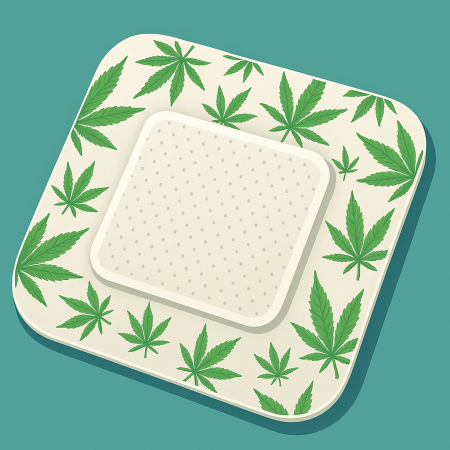
Clinical and Public Health Implications: Where Might This Actually Matter?
The million-dollar question isn’t whether cannabinoids against MRSA can topple bacteria in a petri dish—we already know they can. The real question is: where could that actually matter in the messy, protein-rich, biofilm-prone environments of human health?
The most obvious entry point is topical use. Imagine wound dressings infused with cannabinoids, or gels designed to keep bacterial growth at bay on diabetic ulcers, burns, or surgical incisions. In these scenarios, the concentrations needed to overwhelm bacteria are easier to achieve, and the risk of systemic side effects is lower. CBD already has topical safety data in humans, making it a candidate worth exploring.
Another avenue is device coatings. Catheters, implants, prosthetic joints—these are the playgrounds where MRSA biofilms thrive. A cannabinoid-coated surface that makes it harder for bacteria to stick could save lives, shorten hospital stays, and cut costs. This isn’t science fiction; similar approaches already exist with silver or antibiotic-impregnated devices. Cannabis compounds could, at least in theory, join that roster.
For systemic use, the challenges are tougher. Serum binding, metabolism, and dosing hurdles make it hard to get enough free cannabinoid into the bloodstream to kill bacteria without affecting other systems. That said, even if cannabinoids never become IV antibiotics, their unique mechanisms—membrane disruption, ROS induction, biofilm penetration—may inspire new scaffolds or synergistic therapies. Sometimes a compound’s greatest contribution isn’t as a finished drug, but as a clue that helps us build better ones.
And let’s not forget the broader context: antimicrobial resistance is a global crisis. MRSA alone accounts for over 100,000 deaths worldwide each year. We desperately need fresh strategies. Even if cannabinoids against MRSA only lead to niche applications—say, wound dressings or coated stents—that still represents a meaningful step forward. When lives are at stake, incremental tools aren’t minor; they’re milestones.
How Cannabinoids Compare to Other Natural Antimicrobials
Cannabinoids against MRSA aren’t the only plant- or nature-derived compounds to make microbiologists raise their eyebrows. History is full of surprising antimicrobials hiding in plain sight.
Take honey, for example. Long before antibiotics, it was used as a wound dressing. Modern science later discovered why: honey creates an environment that dehydrates bacteria, lowers pH, and delivers hydrogen peroxide—all of which stress microbes into submission. Manuka honey, in particular, has become something of a celebrity in wound care, thanks to its unique antibacterial compounds.
Or consider garlic. Allicin, the pungent molecule responsible for garlic’s aroma, also has potent antimicrobial activity. It doesn’t always work in vivo at culinary doses (no, a garlic bagel isn’t going to cure sepsis), but it’s another reminder that nature tinkers with antimicrobial strategies just as much as pharmaceutical labs do.
Then there’s N-acetylcysteine (NAC), a small molecule better known as a mucolytic drug and antioxidant supplement. Yet it has an intriguing side hustle: disrupting bacterial biofilms. Researchers have tested NAC against biofilms formed by Pseudomonas, Staphylococcus, and others, and found that it can weaken the sticky matrix, making bacteria more vulnerable to antibiotics.
Where do cannabinoids fit in this lineup? Unlike honey or garlic, they seem to act more like specialists than generalists—poking holes in bacterial membranes, unleashing reactive oxygen chaos, or burrowing into biofilms. That makes them closer cousins to pharmaceutical antibiotics than pantry staples. But like NAC, their biofilm-busting abilities could position them as powerful adjuncts, working alongside existing antibiotics rather than replacing them outright.
This isn’t to pit nature’s remedies against one another. It’s to remind us that the microbial battlefield is wide, and sometimes the most unexpected allies—whether honey, garlic, or cannabinoids—are the ones worth watching.
The Memorable Punchline: Why This Story Sticks
Here’s the thing: most people don’t expect cannabis to show up in the infection-control playbook. Pain, sleep, mood—sure. But superbugs? That feels like a plot twist. And yet, the lab data keep nudging us toward the same conclusion: cannabinoids against MRSA may have real potential, even if we’re still at the starting line of translation.
The most memorable part of this story isn’t just the numbers or the lab graphs. It’s the imagery. CBC sprinting through bacteria like an Olympic runner. CBN sneaking into biofilms like a burglar in the night. CBG poking holes in membranes like a kid with a pin at a balloon party. CBD setting off oxidative fireworks that leave MRSA scrambling for cover. Each one with a role to play, each one part of a chorus of microbial mayhem.
This is what makes the science sticky. Not just the biofilms, but the story itself. The notion that cannabis—long typecast as a plant for pain and peace—might also moonlight as a microbial menace-slayer. It’s a tale that’s both unexpected and oddly memorable.
So the takeaway? Cannabinoids may not be the antibiotics of tomorrow, but they are undeniably bug-busting, biofilm-burgling, ROS-raising oddballs worth paying attention to. Or, to put it in a phrase that will hopefully rattle around in your brain long after you close this tab: bug-face, drug-face, snug-face—because sometimes, the strangest allies are the ones we need most in the fight against infectious disease.
Internal Links from CEDclinic.com
1. Testing Essential Oils of Industrial Hemp Against Bacteria
Industrial hemp oils with antimicrobial action
Discusses hemp essential oils showing antimicrobial activity—parallels well with cannabinoids versus MRSA and supports the natural antimicrobial narrative.
https://cedclinic.com/testing-essential-oils-of-industrial-hemp-against-bacteria/
2. Topical Cannabis Products (Wound Healing & Infection Control)
Cannabis topicals for wound healing and infection control
Details how topicals—including for bacterial overgrowth and wound healing—leverage cannabinoids, aligning closely with your clinical implications section.
https://cedclinic.com/topical-cannabis-products/
3. Is cannabis an antibiotic savior in antibiotic-induced bacteremia?
Cannabis potentially reducing infections like C. difficile
Explores data and mechanisms related to cannabis as an antimicrobial, in a clinical scenario. It’s complementary context.
https://cedclinic.com/is-cannabis-an-antibiotic-savior-in-antibiotic-induced-bacteremia/
4. Conditions That Cannabis Treats (including chronic infections)
Cannabis care for chronic infections
Mentions “chronic infections” among conditions cannabis may help, grounding your blog’s theme within broader therapeutic areas.
https://cedclinic.com/conditions-that-cannabis-treats/
External Links:
Back in 2008, a team led by Giovanni Appendino published a now-classic paper in Journal of Natural Products. They showed that the five major cannabinoids—CBD, THC, CBN, CBG, and CBC—could all stop MRSA strains in their tracks, often at concentrations comparable to standard antibiotics. That was the “spark” paper, the one that planted a seed in microbiology circles (Appendino et al. 2008).
Fast forward to 2020, when Farha and colleagues dug deeper into CBG. Their work in ACS Infectious Diseases revealed that CBG doesn’t just work in test tubes; it can also eradicate biofilms and kill “persister” cells, and — strikingly — it treated MRSA infections in mice (Farha et al. 2020).
Then in 2021, Blaskovich and colleagues confirmed CBD’s activity against Gram-positive bacteria, including MRSA. They also highlighted a critical limitation: CBD’s potency plunges in the presence of serum. Still, they demonstrated topical efficacy in skin infection models.
This is what makes the science sticky. Not just the biofilms, but the story itself. The notion that cannabis—long typecast for pain or mood—might also moonlight as a microbial menace-slayer. It’s an unexpected twist, but one grounded in peer-reviewed evidence.
Curious Facts About MRSA
Global MRSA & AMR burden (what scale are we talking about?)
-
In 2019, antibacterial resistance was linked to an estimated 4.95 million associated deaths and 1.27 million attributable deaths worldwide.
-
Within those estimates, MRSA (methicillin-resistant S. aureus) was one of the single biggest drug–pathogen contributors, responsible for “more than 100,000” deaths worldwide in 2019.
-
In the Americas alone (2019), MRSA accounted for an estimated 23,400 attributable deaths (95% UI 10,000–39,000).
Colonization & who carries it
-
About 1 in 3 people (≈33%) carry S. aureus (usually in the nose) at any given time, typically without illness.
-
About 2 in 100 people (≈2%) in the U.S. are MRSA carriers (colonized), with higher rates in certain risk groups.
-
Among hospitalized children, colonization matters: in one reviewed dataset, 8.5% of children colonized on admission later developed MRSA infection; in PICU patients who acquired MRSA colonization, 47% developed MRSA infection.
U.S. illness & deaths (how big is the problem here?)
-
In 2017, the U.S. recorded an estimated 119,247 S. aureus bloodstream infections with 19,832 associated deaths (this total includes both MRSA and MSSA).
-
Trend lines (U.S., 2005–2016): hospital-onset MRSA bloodstream infections fell about 17.1% per year (2005–2012), then the decline slowed (2013–2016); community-onset MRSA declined more modestly (≈6.9% per year, 2005–2016).
-
Context: across all AMR threats (not just MRSA), the CDC estimates >2.8 million resistant infections and >35,000 deaths in the U.S. each year (reporting framework from the 2019 AR Threats Report).
-
Additional U.S. context: people who inject drugs accounted for nearly 1 in 10 serious staph infections in 2016, highlighting a key risk pocket.
Europe (incidence & resistance snapshot)
-
EU/EEA MRSA bloodstream infection incidence fell from 5.63 per 100,000 (2019) to 4.64 per 100,000 (2023)—a 17.6% decrease overall.
-
Resistance proportions vary widely: in 2021, 11 of 44 countries reported MRSA <5% of S. aureus isolates, but 13 of 44 reported ≥25%.
Costs of care (what does MRSA do to budgets?)
-
Healthcare-associated infections (HAIs)—of which MRSA is a major contributor—cost U.S. hospitals an estimated $28–$45 billion annually (range reflects methodological differences; seminal analysis).
-
Community-associated MRSA (CA-MRSA): a single case was estimated to cost $2,277–$3,200 to third-party payers and $7,070–$20,489 to society (age-dependent; U.S. modeling).
-
MRSA vs MSSA costs (U.S. hospitalizations, 2010–2014): contrary to older assumptions, a national analysis found costs converged, with MSSA pneumonia sometimes costing more than MRSA pneumonia by 2014; however, mortality remained higher with MRSA hospitalizations after adjustment.
-
Recent hospital studies continue to show MRSA infections lengthen stay and inflate charges compared with MSSA or colonization-only cohorts, though mortality differences are inconsistent across settings.
How MRSA stacks up against other bacterial threats
-
In the global AMR landscape (2019), MRSA is consistently ranked among the top high-burden drug–pathogen pairs for mortality, alongside E. coli, Klebsiella pneumoniae, Streptococcus pneumoniae, Acinetobacter baumannii, and Pseudomonas aeruginosa.
-
In the Americas, MRSA was the only pathogen–drug combination with >20,000 attributable deaths in 2019—underscoring its regional impact relative to other resistant organisms.
Quick clarifications (common pitfalls I double-checked)
-
“119,247 infections / 19,832 deaths” refers to all S. aureus bloodstream infections (MRSA plus MSSA), not MRSA alone.
-
The “>100,000 MRSA deaths globally” figure is from the Lancet AMR analysis summarized by Oxford; it’s global (not U.S.) and pertains to 2019.
-
U.S. colonization rates (“1 in 3” for S. aureus, “2 in 100” for MRSA) come directly from CDC clinical/overview pages updated in 2025.
References
-
Murray CJL, Ikuta KS, Sharara F, Swetschinski L, Aguilar GR, et al. Global burden of bacterial antimicrobial resistance in 2019: a systematic analysis. The Lancet. 2022;399(10325):629–655. doi:10.1016/S0140-6736(21)02724-0.
-
Centers for Disease Control and Prevention (CDC). Antibiotic Resistance Threats in the United States, 2019. Atlanta, GA: U.S. Department of Health and Human Services, CDC; 2019. (Report).
-
Kourtis AP, Hatfield K, Baggs J, Mu Y, See I, et al. Vital Signs: Epidemiology and recent trends in methicillin-resistant and in methicillin-susceptible Staphylococcus aureus bloodstream infections—United States. MMWR Morbidity and Mortality Weekly Report. 2019;68(9):214–219. doi:10.15585/mmwr.mm6809e1.
-
Centers for Disease Control and Prevention (CDC). Clinical Overview of Methicillin-Resistant Staphylococcus aureus (MRSA). Atlanta, GA: CDC; last reviewed June 27, 2025. (Web guidance page).
-
European Centre for Disease Prevention and Control (ECDC) and WHO Regional Office for Europe. Antimicrobial resistance surveillance in Europe 2023—2021 data. Stockholm: ECDC; 2023. (Report).
-
Klein EY, Jiang W, Mojica N, Tseng KK, McNeill R, Cosgrove SE, Perl TM. National costs associated with methicillin-susceptible and methicillin-resistant Staphylococcus aureus hospitalizations in the United States, 2010–2014. Clinical Infectious Diseases. 2019;68(1):22–28. doi:10.1093/cid/ciy399.
-
Lee BY, Singh A, David MZ, Bartsch SM, Slayton RB, Huang SS, et al. The economic burden of community-associated methicillin-resistant Staphylococcus aureus (CA-MRSA). Clinical Microbiology and Infection. 2013;19(6):528–536. doi:10.1111/j.1469-0691.2012.03914.x.
-
Scott RD II. The Direct Medical Costs of Healthcare-Associated Infections in U.S. Hospitals and the Benefits of Prevention. Atlanta, GA: U.S. Department of Health and Human Services, CDC; 2009. (White paper).
-
Stone PW. Economic burden of healthcare-associated infections: an American perspective. Expert Review of Pharmacoeconomics & Outcomes Research. 2009;9(5):417–422. doi:10.1586/erp.09.53.
-
Milstone AM, Carroll KC, Ross T, Shangraw KA, Perl TM. Methicillin-resistant Staphylococcus aureus colonization and risk of subsequent infection in critically ill children: importance of preventing nosocomial MRSA transmission. Clinical Infectious Diseases. 2011;53(9):853–859. doi:10.1093/cid/cir520.
-
Liu C, Bayer A, Cosgrove SE, Daum RS, Fridkin SK, et al.; Infectious Diseases Society of America. Clinical practice guidelines by the Infectious Diseases Society of America for the treatment of methicillin-resistant Staphylococcus aureus infections in adults and children. Clinical Infectious Diseases. 2011;52(3):e18–e55. doi:10.1093/cid/ciq146.
-
Centers for Disease Control and Prevention (CDC). Antimicrobial Resistance: Facts & Stats. Atlanta, GA: CDC; updated February 4, 2025. (Summary page consolidating the 2019 AR Threats estimates).
10 FAQ Questions on the topic!
Q1: Can cannabinoids kill MRSA?
Yes, in laboratory studies cannabinoids against MRSA showed potent antibacterial activity at very low concentrations. Compounds like CBC, CBG, and CBN were especially effective at killing bacteria and disrupting biofilms. However, this research is still preclinical and not yet applied in human medicine.
Q2: Which cannabinoid is most effective against MRSA?
CBC stood out as the fastest killer, wiping out MRSA populations within 30–60 minutes in vitro. CBN and CBG also showed strong biofilm-busting activity, while CBD was best at damaging bacterial membranes. THC played a supportive but less dramatic role in these assays.
Q3: How do cannabinoids fight MRSA?
Cannabinoids against MRSA appear to work by damaging bacterial membranes and triggering oxidative stress (ROS). This combination overwhelms bacteria, leading to rapid death. Each cannabinoid uses a slightly different style—some sprint, some sneak, some puncture.
Q4: Are cannabinoids as strong as antibiotics like vancomycin?
In this lab study, CBD’s MIC against MRSA matched vancomycin’s, and other cannabinoids were even lower. But that doesn’t mean they work the same way in patients. Human bodies are complex, and cannabinoids often lose potency in serum or tissue environments.
Q5: Can cannabinoids be used as antibiotics in hospitals?
Not yet. While cannabinoids against MRSA show promise in the lab, translating them into hospital use requires extensive safety testing, animal studies, and clinical trials. The most realistic first applications may be topical wound dressings or device coatings.
Q6: Do cannabinoids work against biofilms?
Yes. CBN and CBG in particular reduced MRSA biofilm viability by up to 85% in lab experiments. Biofilms are one of the hardest challenges in infection control, so this is a significant finding—even if still confined to the lab.
Q7: Could cannabis oil cure an infection?
No. The antimicrobial effects reported are from purified cannabinoids studied in controlled lab settings. Cannabis oil or consumer products are not proven to treat infections and should not replace antibiotics or medical care.
Q8: Are cannabinoids effective against all bacteria?
No. Cannabinoids generally show stronger activity against Gram-positive bacteria like MRSA. Against Gram-negatives, their effect is much weaker unless the bacterial outer membrane is compromised.
Q9: What natural products compare to cannabinoids against MRSA?
Other natural agents like honey, garlic (allicin), and N-acetylcysteine also show biofilm-disrupting or antimicrobial properties. Cannabinoids stand out for their multi-pronged tactics—membrane damage, ROS induction, and rapid bactericidal activity.
Q10: What’s the future of cannabinoids in infectious disease care?
The future may involve topical therapies, wound dressings, or device coatings that incorporate cannabinoids. Even if cannabinoids themselves don’t become systemic antibiotics, their mechanisms may inspire new classes of antimicrobials. And my hunch – lots of people are going to want to experiment on their own!
